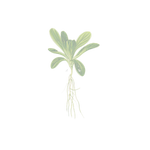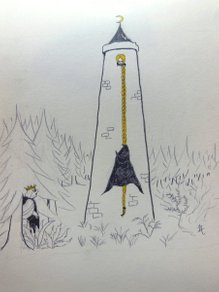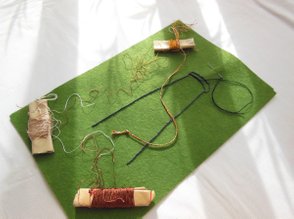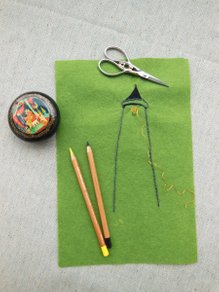Click on the images to enlarge them!
2018
Rapunzel
When the woman gave birth, the sorceress appeared, named the little girl Rapunzel, and took her away. Rapunzel became the most beautiful child under the sun. When she was twelve years old, the sorceress locked her in a tower that stood in a forest and that had neither a door nor a stairway, but only a tiny little window at the very top.
When the sorceress wanted to enter, she stood below and called out:
One day the woman was standing at this window, and she saw a bed planted with the most beautiful rapunzel. It looked so fresh and green that she longed for some. It was her greatest desire to eat some of the rapunzel. This desire increased with every day, and not knowing how to get any, she became miserably ill.
Her husband was frightened, and asked her, "What ails you, dear wife?"
"Oh," she answered, "if I do not get some rapunzel from the garden behind our house, I shall die."
The man, who loved her dearly, thought, "Before you let your wife die, you must get her some of the rapunzel, whatever the cost."
So just as it was getting dark he climbed over the high wall into the sorceress's garden, hastily dug up a handful of rapunzel, and took it to his wife. She immediately made a salad from it, which she devoured eagerly. It tasted so very good to her that by the next day her desire for more had grown threefold. If she were to have any peace, the man would have to climb into the garden once again. Thus he set forth once again just as it was getting dark. But no sooner than he had climbed over the wall then, to his horror, he saw the sorceress standing there before him.
"How can you dare," she asked with an angry look, "to climb into my garden and like a thief to steal my rapunzel? You will pay for this."
"Oh," he answered, "Let mercy overrule justice. I came to do this out of necessity. My wife saw your rapunzel from our window, and such a longing came over her, that she would die, if she did not get some to eat."
The sorceress's anger abated somewhat, and she said, "If things are as you say, I will allow you to take as much rapunzel as you want. But under one condition: You must give me the child that your wife will bring to the world. It will do well, and I will take care of it like a mother."
In his fear the man agreed to everything.
Rapunzel, Rapunzel,
Let down your hair to me.
Rapunzel had splendid long hair, as fine as spun gold. When she heard the sorceress's voice, she untied her braids, wound them around a window hook, let her hair fall twenty yards to the ground, and the sorceress climbed up it.
Once upon a time there was a man and a woman who had long, but to no avail, wished for a child. Finally the woman came to believe that the good Lord would fulfill her wish. Through the small rear window of these people's house they could see into a splendid garden that was filled with the most beautiful flowers and herbs. The garden was surrounded by a high wall, and no one dared enter, because it belonged to a sorceress who possessed great power and was feared by everyone.
The Fairy Tale
A few years later it happened that a king's son was riding through the forest. As he approached the tower he heard a song so beautiful that he stopped to listen. It was Rapunzel, who was passing the time by singing with her sweet voice. The prince wanted to climb up to her, and looked for a door in the tower, but none was to be found.
He rode home, but the song had so touched his heart that he returned to the forest every day and listened to it. One time, as he was thus standing behind a tree, he saw the sorceress approach, and heard her say:
Rapunzel, Rapunzel,
Let down your hair.
Then Rapunzel let down her strands of hair, and the sorceress climbed up them to her.
"If that is the ladder into the tower, then sometime I will try my luck."
And the next day, just as it was beginning to get dark, he went to the tower and called out:
Rapunzel, Rapunzel,
Let down your hair.
The hair fell down, and the prince climbed up.
The sorceress did not notice what was happening until one day Rapunzel said to her, "Frau Gothel, tell me why it is that you are more difficult to pull up than is the young prince, who will be arriving any moment now?"
"You godless child," cried the sorceress. "What am I hearing from you? I thought I had removed you from the whole world, but you have deceived me nonetheless."
In her anger she grabbed Rapunzel's beautiful hair, wrapped it a few times around her left hand, grasped a pair of scissors with her right hand, and snip snap, cut it off. And she was so unmerciful that she took Rapunzel into a wilderness where she suffered greatly.
At first Rapunzel was terribly frightened when a man such as she had never seen before came in to her. However, the prince began talking to her in a very friendly manner, telling her that his heart had been so touched by her singing that he could have no peace until he had seen her in person. Then Rapunzel lost her fear, and when he asked her if she would take him as her husband, she thought, "He would rather have me than would old Frau Gothel." She said yes and placed her hand into his.
She said, "I would go with you gladly, but I do not know how to get down. Every time that you come, bring a strand of silk, from which I will weave a ladder. When it is finished I will climb down, and you can take me away on your horse."
They arranged that he would come to her every evening, for the old woman came by day.
The prince climbed up, but above, instead of his beloved Rapunzel, he found the sorceress, who peered at him with poisonous and evil looks.
"Aha!" she cried scornfully. "You have come for your Mistress Darling, but that beautiful bird is no longer sitting in her nest, nor is she singing any more. The cat got her, and will scratch your eyes out as well. You have lost Rapunzel. You will never see her again."
On the evening of the same day that she sent Rapunzel away, the sorceress tied the cut-off hair to the hook at the top of the tower, and when the prince called out:
Rapunzel, Rapunzel,
Let down your hair,
she let down the hair.
He heard a voice and thought it was familiar. He advanced toward it, and as he approached, Rapunzel recognized him, and crying, threw her arms around his neck. Two of her tears fell into his eyes, and they became clear once again, and he could see as well as before. He led her into his kingdom, where he was received with joy, and for a long time they lived happily and satisfied.
The prince was overcome with grief, and in his despair he threw himself from the tower. He escaped with his life, but the thorns into which he fell poked out his eyes. Blind, he wandered about in the forest, eating nothing but grass and roots, and doing nothing but weeping and wailing over the loss of his beloved wife. Thus he wandered about miserably for some years, finally happening into the wilderness where Rapunzel lived miserably with the twins that she had given birth to.
Sources
Text: The Grimm Brothers' Children's and Household Tales (Grimms' Fairy Tales), compiled, translated, and classified by D. L. Ashliman, © 1998-2020
Background Image: Wikipedia, Valerianella locusta. Original book source: Prof. Dr. Otto Wilhelm Thomé Flora von Deutschland, Österreich und der Schweiz, 1885, Gera, Germany. Permission granted to use under GFDL by Kurt Stueber. Source: http://www.biolib.de/
A Tower, a Sorceress, and a Fat Prince
One night this February my imagination began to run full speed. I came up with so many great pictures to stitch up, including fairy-tales, and one of them was Rapunzel: how she's peeping out of a tower, very small, in worm's-eye view, her overlong braid dangling down with the heavyweight Frau Gothel clinging to it, of which you see the backside only, and this backside is large and black and sinister, with a sharp-horned hood. At the left again, half-hidden below dark conifers, the fat prince is waiting, watching the scene, and he's about to put a very similar black cloak on.
You see, my interpretation of fairy-tales is somewhat off the common reading at times. That is probably what happens when you're used to do soul journeys. Let your soul travel into a fairy-tale, and it will come up with images that seemingly have little in common with the story as it is told in the book, but which reveal a very special, subjective truth. It was obvious to me that the prince not only has to be fat, but that he has to be nothing but a (covert at first) extension to the repressive "mother". You better think twice, Rapunzels of the world, whether your "great love" will really free you from your abusive parents, or if it is rather a bubble of an alluring illusion! The bubble might burst, at the latest after "giving birth to twins", and then it is usually too late to run.
My thought was to embroider the pic on a mossy green felt in order to match the background to the woods surrounding the tower. It was supposed to be an experiment from the beginning, that is why I grabbed a piece of green craft felt and a bunch of very old threads: old pearl cotton and rayon from my aunt's stash. My reference was nothing but a raw sketch - no transfer, no drawing on the felt, I wanted to try how a completely free embroidery would work out.
The Sketch
The Joy of Free Stitching
After stitching the outlines of the tower, I pieced together six strands of rayon in three colours - gold, brown and a silverish grey - for the braid. I had the idea to actually plait it and to attach it in several places so that it would really dangle from above. As it turned out, six strands resulted in a quite thin braid, but it was okay.
The Tower and a Plaited Braid Made of Old Rayon
When I next tried to stitch the little head of hair with the smaller still face beneath, I realised how hard it is to stitch without pre-drawn lines! I had to frog it several times until it looked more or less as I was imagining it - with the result of a small hole in the felt.
Also the tower outlines didn't stitch smoothly. You might think (at least I was thinking so), ok, how hard it can be to estimate the placing of the stitches to get the impression of a tapering upwards tower? Yet it can be hard! Not least because of the felt, where there is no thread grid to roughly stick to. In the end, I had to measure the main distances on the drawing and then transfer it to the felt, marking the point with pins.
Rapunzel Peeping out of the Tower
The tower outlines are done with grey pearl cotton #5 in outline stitch, the shadow beneath the breastwork with black pearl cotton in stem stitch. Next I drew the pointed roof in. I decided on Bokhara couching in black. Unfortunately, Mary Thomas's explanation of this stitch remained a mystery to me, hence I had to fall back once again to Mary Corbet's How To Video for Bokhara couching. To get it about right, I outlined the roof in split stitch first. The hints of the brickwork again were done in buttonhole stitch.
After outlining Rapunzel's face and hair in split stitch, I filled them with Long-and-Short-Stitch. I felt that the face had to throw a shadow as well, which I did in black Seed Stitch. I would rather have used green, since now it looked as if Rapunzel had a beard ... 😹 All that was done with rayon, and I found that I liked it.
If I had to spend half of my life in a tower, I would grow a beard, too. 😂
After the braid was pulled through and fixed, I drew the sorceress's cloak on a black canvas and adorned it with a white cobweb and bug in (pseudo) spider web and straight stitches, marked hood and arms in a darker grey, cut it out, basted it in place and appliquéd it with buttonhole stitch. It was a bit annoying, because canvas is fraying wildly. I should have cut out a larger piece and neatened it first.
Main motif done! Now, I could mess about with the plants at the bottom of the tower. And it was at this point that free stitching turned into fun! There are so many stitches suited for grass and similar plants: fishbone, outline, maidenhair, wheatear, feather stitch ... Plus I could use the green-and-blue palette of the rayon. I wanted some briar matching the subject and was browsing the stitch dictionaries. And in fact! There is a stitch in Mary Thomas's Dictionary of Embroidery Stitches, and it is even called thorn stitch!
Rapunzel, Rapunzel! Let Down Your Hair!
On to the forest. I was a long time looking for a stitch suited for the rough childish outlines of conifers. There was a stitch in Thomas's dictionary, called Japanese stitch, that caught my eye. I decided to give it a try. I draw comfort from the thought that the sketchy nature of the whole piece accommodates my rugged performance ... The stems are done in stem stitch (what else?) in two colours to emphasise light and shadow and provide a certain plasticity.
Grasses, Briars, Trees ... Work in Progress
to be continued ...





